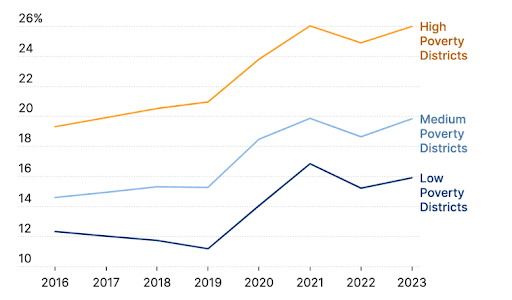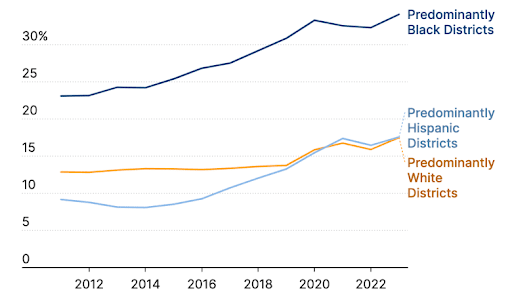Resource: Brookings, “Declining public school enrollment,” August 2025
Independent school enrollment level
Prior to the pandemic, the share of students in conventional public colleges held stable, floating near 85 percent between 2016 and 2020 After the pandemic, traditional public institution enrollment dropped to listed below 80 percent and hasn’t recoiled.
The mystical absent kids represent a large piece of the decline. Yet families additionally switched to charter and virtual schools. Charter college enrollment climbed from 5 percent of pupils in 2016 – 17 to 6 percent in 2023 – 24 The variety of kids participating in online institutions almost doubled from 0. 7 percent prior to the pandemic in 2019 – 20 to 1 2 percent in 2020 – 21 and has actually stayed elevated.
Remarkably, private school registration has actually remained constant at virtually 9 percent of school-age youngsters between 2016 – 17 and 2023 – 24, according to this Brookings price quote.
I had expected independent school registration to increase, as families soured on public institution disturbances during the pandemic, and as 11 states, consisting of Arizona and Florida, released their very own academic interest-bearing account or brand-new voucher programs to help pay the tuition. But another analysis , launched this month by researchers at Tulane College, echoed the Brookings numbers. It located that private school enrollments had increased by just 3 to 4 percent in between 2021 and 2024, compared to states without vouchers. A new federal tax debt to money private school scholarships is still even more than a year far from entering into result on Jan. 1, 2027, and perhaps a better change into exclusive education and learning is still ahead.
Defections from typical public institutions are largest in Black and high-poverty areas
I would certainly have thought that wealthier families who can afford private school tuition would be most likely to look for choices. However high-poverty areas had the biggest share of students outside the conventional public-school industry. In addition to independent school, they were signed up in charters, digital schools, specialized schools for trainees with specials needs or various other alternate colleges, or were homeschooling.
Greater than 1 in 4 trainees in high-poverty districts aren’t enlisted in a conventional public college, compared with 1 in 6 pupils in low-poverty institution areas. The steepest public institution enrollment losses are focused in mainly Black institution districts. A third of trainees in mainly Black areas are not in standard public schools, double the share of white and Hispanic students.
Share of student enrollment outside of standard public colleges, by district destitution

Resource: Brookings, “Decreasing public institution registration,” August 2025
Share of students not enrolled in standard public colleges by race and ethnic background

Source: Brookings, “Declining public college registration,” August 2025
These inconsistencies matter for the trainees who continue to be in conventional public institutions. Schools in low-income and Black communities are currently losing one of the most trainees, requiring also steeper budget cuts.
The demographic timebomb
Prior to the pandemic, united state colleges were already gone to a huge contraction. The average American female is now bring to life just 1 7 children over her lifetime, well listed below the 2 1 fertility rate needed to change the populace. Fertility prices are forecasted to drop better still. The Brookings experts assume more immigrants will continue to enter the nation, in spite of current immigration restrictions, yet not nearly enough to offset the decline in births.
Also if households return to their pre-pandemic enrollment patterns, the population decline would certainly mean 2 2 million fewer public school students by 2050 Yet if parents maintain choosing various other type of institutions at the speed observed since 2020, traditional public institutions could lose as numerous as 8 5 million students, shrinking from 43 06 million in 2023 – 24 to as couple of as 34 57 million by mid-century.
In between students gone missing, the options some Black families and families in high-poverty areas are making and how many youngsters are being born, the general public college landscape is changing. Twist up and prepare yourself for mass public institution closures
This tale concerning institution enrollment decreases was generated by The Hechinger Report , a not-for-profit, independent wire service focused on inequality and development in education and learning. Enroll in Proof Details and other Hechinger e-newsletters